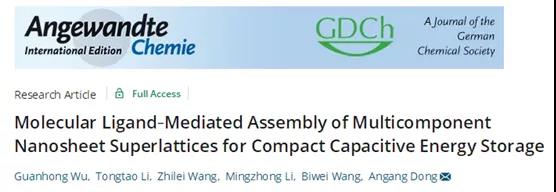
hotline:
17715390137
Tel/Wechat:
18101240246 (Technology)
0512-68565571
Email:mxenes@163.com (Sales Engineer)bkxc.bonnie@gmail.com
Scan the code to follow or search the official account on WeChat:
2D Materials Fronrier After paying attention,
click on the lower right corner to contact us,
Enter enterprise WeChat.
Professional Services Online



The development of atomic-scale thin-layer nanosheets, the so-called 2D materials, has attracted great research attention because of its intrinsic properties such as good specific surface area and unique slit-like channels. Most exfoliated nanosheet materials have a rich surface chemistry, including exposed polar atoms and functional groups or surface charges, so that they can be dissolved in some polar solvents. Because of this, a variety of solutions have been applied to construct superstructures, such as laminated films, hydrogels, aerogels, and so on. Especially the densely stacked nanosheets in the laminate film are very competitive in electrochemical energy storage due to their high flexibility. However, the laminated film usually suffers from slow electrochemical kinetics due to the severe self-stacking of nanosheets, which hinders the diffusion and adsorption of electrolyte ions. The conventional strategy to solve this problem is to composite with other 2D materials to prepare 2D/2D heterostructures. In addition to alleviating the self-stacking problem, the 2D/2D heterojunction can also synergistically integrate different nanosheets to generate new properties. Another way is to combine two different nanosheet materials together through electrostatic assembly, but the packing density of the assembled materials in this way is usually low, which is not conducive to energy storage. Therefore, it is still a challenge to prepare 2D/2D heterojunction materials with high packing density and uniform interlayer channels for energy storage.

Recently, Professor Dong Angang of Fudan University published a research paper titled: Molecular Ligand-Mediated Assembly of Multicomponent Nanosheet Superlattices for Compact Capacitive Energy Storage in the top international academic journal Angewandte Chemie International Edition, on the use of a molecular ligand-assisted assembly strategy , Successfully assembled Ti3C2Tx and rGO together. Through heat treatment, this MXene-rGO superlattice has a controllable microstructure and a higher capacitance. In addition, this binder-free symmetrical supercapacitor exhibits an ultra-high energy density, which is the highest among the currently reported aqueous electrolyte MXene-based materials.


Figure 1. Schematic diagram of synthesis of MXene-rGO composite membrane assisted by ligand assembly.

Figure 2. TEM and AFM images and infrared and XRD patterns of MXene-rGO composite film.

Figure 3. HRTEM image, cross-sectional SEM image and physical image of MXene-rGO composite film.

Figure 4. HRTEM image, XRD and Raman spectra of MXene-rGO composite film, and different rGO content density and conductivity.

Figure 5. Electrochemical performance test of MXene-rGO composite membrane.

In this study, the researchers proposed a molecular ligand-assisted colloidal assembly strategy, which can assemble single-component and multi-component nanosheet materials into high packing density and high-quality laminated high-quality laminates Superlattice. The molecular ligands attached to the surface of the nanosheets can not only promote the orderly assembly of the 2D superlattice film, but also can be converted into a disordered carbon matrix, which can promote the rapid transmission of ions between layers. Compared with similar films, the composite MXene-rGO laminate film has a higher density due to its close-packed nature and highly ordered stacking. The MXene-rGO film can produce an ultra-high volume capacitance of 1443 F cm-3 at a scanning speed of 2 mV s-1, and a symmetrical supercapacitor based on this composite film has an ultra-high energy density of 42.1 Wh L-1. This strategy provides new ideas for the assembly of 2D/2D heterojunctions.
Literature link:
https://doi.org/10.1002/anie.202009086
This information is from the Internet for academic exchanges. If there is any infringement, please contact us and delete it immediately

| Reminder: Beijing Beike New Material Technology Co., Ltd. supplies products only for scientific research, not for humans |
| All rights reserved © 2019 beijing beike new material Technology Co., Ltd 京ICP备16054715-2号 |